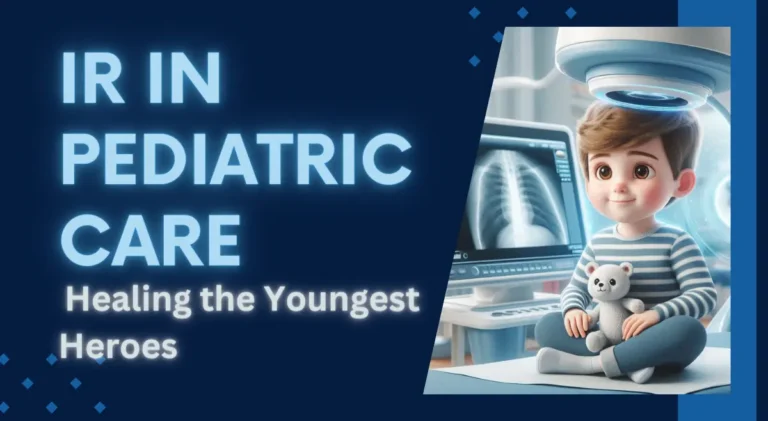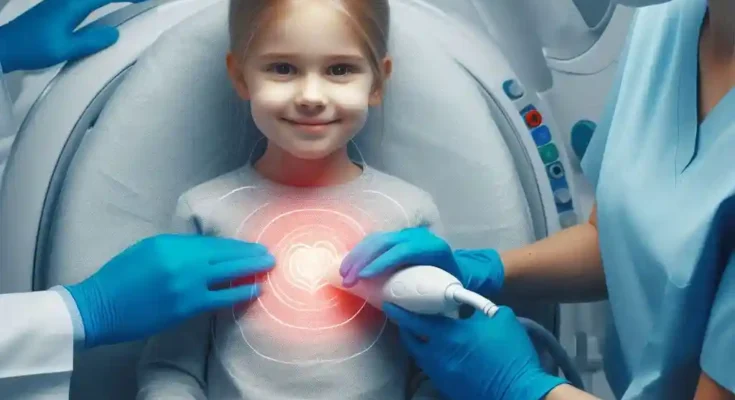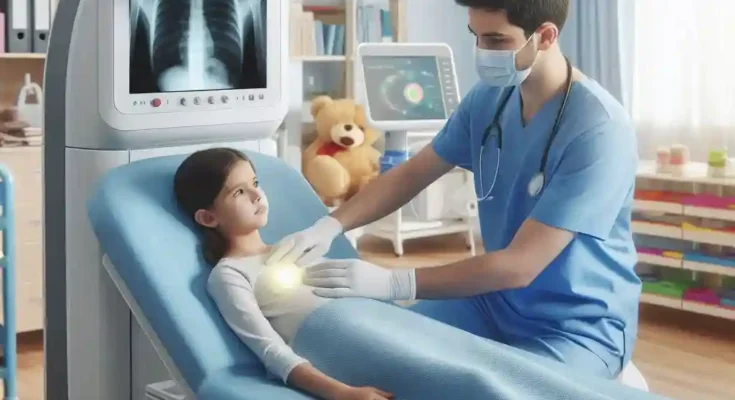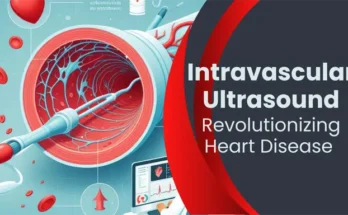
Interventional Radiology: A Guide for Young Minds
- IR in Pediatric Care might seem like something from a futuristic film, but it’s a fascinating and vital branch of medicine that allows doctors to address a wide array of health issues in children without resorting to major surgeries. Let’s explore the incredible world of IR and discover why it’s such an amazing option for our young ones!
- What Exactly is Interventional Radiology? Imagine you have a team of medical ninjas who can sneak into your body and fix problems without anyone noticing. That’s kind of what IR doctors do. They use special tools and imaging techniques, like X-rays and ultrasounds, to see inside your body and treat conditions through tiny incisions. It’s less scary and way less painful than traditional surgery.
- Why is IR Important for Kids? Kids aren’t just mini-adults; they have their own specific health needs. Pediatric IR is tailored just for them, making sure that treatments are safe, less painful, and as non-scary as possible. Plus, because the incisions are so small, kids can usually get back to being their playful selves much quicker.
- The Magic of Minimally Invasive Procedures Minimally invasive means that there’s minimal cutting involved. It’s like using a magic wand to heal from the inside. This approach is great because it reduces the risk of infection, causes less pain, and often requires no overnight stays in the hospital. It’s all about getting better faster and with less fuss.
- IR Treatments: Not Just for the Big Stuff You might think that IR is only for serious conditions, but it’s also used for more common issues that kids face. From fixing broken blood vessels to removing things that shouldn’t be there (like a pesky appendix), IR covers a wide range of treatments.
- Learning from the pros, IR doctors, also known as interventional radiologists, are like the wizards of the medical world. They’ve gone to school for many years to learn how to use their imaging spells to help patients. They’re always happy to explain what they’re doing, so don’t be afraid to ask questions!
- IR: A Peek into the Future The coolest part about IR is that it’s always getting better. New technologies and tools are being developed all the time, which means treatments are becoming even safer and more effective. It’s an exciting field that’s constantly evolving, and who knows? Maybe some of you reading this will become the next generation of IR experts!
Table of Contents
The Role of IR in Treating Pediatric Patients
Interventional radiology (IR) is a game-changer in the medical field, and its role in pediatric care is nothing short of remarkable. Let’s explore how IR is making a difference in the lives of children who need medical care.
IR in Pediatric Care: A Kinder Approach to Treatment” offers a more gentle alternative to traditional surgery, focusing on minimizing discomfort and maximizing healing for children. With IR in pediatric care, young patients don’t have to be concerned about large scars or extended hospital stays. Often, they can return home on the same day as their procedure.
“Tailored Care for Tiny Patients” emphasizes that children are not just miniature adults; they are in a constant state of growth and development. This is precisely why IR in pediatric care procedures is meticulously designed to be safe and effective for the younger population. The equipment utilized is often smaller and more precise, ensuring that treatments are as non-invasive and tailored as possible for our little ones.
Wide Range of Treatments IR isn’t limited to one type of treatment or condition. It’s used for a variety of health issues that can affect children, including:
- Vascular malformations: correcting blood vessel abnormalities without major surgery.
- Cancer Treatment through Tumor Targeting: Administering medication directly to the tumor site diminishes the reliance on systemic chemotherapy.
- Organ biopsies: Taking small tissue samples with minimal discomfort.
- Feeding tube placements: Helping kids who have trouble eating get the nutrition they need.
Speedy Recovery, Happy Kids One of the biggest benefits of IR is the quick recovery time. Kids can bounce back faster, which means less time away from school and play. Parents also appreciate the reduced stress and worry that comes with less invasive procedures.
Collaborative Care Pediatric IR isn’t a solo act. It involves a team of specialists, including pediatricians, anesthesiologists, nurses, and radiologists, all working together to provide the best care for young patients. This teamwork ensures that every aspect of the child’s well-being is considered.
Empowering Young Patients: IR procedures often involve conscious sedation, which means that kids stay awake but don’t feel pain. This can be empowering, as they get to be active participants in their own care. Plus, they can often watch a movie or listen to music during the procedure, which helps keep them calm and distracted.
Education and Support: Pediatric IR teams also focus on educating kids and their families about the procedures. They provide resources and support to ensure that everyone understands what to expect and feels comfortable with the treatment plan.
In conclusion, the role of IR in pediatric care is vital. It offers a compassionate, efficient, and effective way to treat a wide range of medical conditions, all while keeping the unique needs of children at the forefront. It’s a blend of science, technology, and heart that’s making a real difference in the lives of young patients.

Common Pediatric Conditions Treated with IR
Interventional radiology (IR) is like a superhero’s toolkit for doctors, allowing them to tackle various health challenges that children might face. Here’s a closer look at some common pediatric conditions that IR can treat, making a big difference in little lives.
Vascular Anomalies: The Blood Vessel Blueprint
- What They Are: Vascular anomalies are like typos in the body’s blueprint for blood vessels. They can be veins, arteries, or lymph vessels that haven’t formed correctly.
- How IR Helps: IR can correct these with procedures like sclerotherapy, where doctors inject a special solution to shrink the abnormal vessels.
Appendicitis: The Troublesome Appendix
- What It Is: Appendicitis is when the appendix gets inflamed and angry, causing a lot of pain.
- How IR Helps: Instead of traditional surgery, IR can sometimes treat appendicitis by draining the infection through a small tube.
Liver Diseases: Keeping the Filter Fit
- What They Are: The liver is like the body’s filter, and diseases here can cause serious issues.
- How IR Helps: IR can perform biopsies to diagnose problems or place shunts to help the liver do its job.
Kidney Conditions: The Body’s Cleaning Crew
- What They Are: Kidney conditions can affect how the body cleans the blood.
- How IR Helps: IR can use angioplasty to open narrowed blood vessels or perform ablations to treat tumors.
Bone and Joint Infections: Defending the Framework
- What They Are: Infections in bones and joints can weaken the body’s framework.
- How IR Helps: IR can drain infections or deliver antibiotics directly to the area, helping to preserve strength and mobility.
Tumors: The Unwanted Guests
- What They Are: Tumors are like unwanted guests in the body that can cause trouble.
- How IR Helps: IR can target these tumors with treatments that cut off their blood supply or deliver chemotherapy right to them.
Foreign Body Retrieval: Getting Rid of Uninvited Objects
- What It Is: Sometimes, things that shouldn’t be in the body get stuck there, like a bead in the nose or a swallowed coin.
- How IR Helps: IR can safely remove these objects without big cuts, often relieving a lot of worry for both kids and parents.
Hydrocephalus: Managing Brain Waterways
- What It Is: Hydrocephalus is when there’s too much fluid in the brain’s waterways.
- How IR Helps: IR can place shunts to redirect the fluid and relieve pressure.
Feeding Difficulties: Nourishing the Young
- What They Are: Some kids have trouble eating and need help getting nutrition.
- How IR Helps: IR can place feeding tubes in a way that’s less invasive and more comfortable for the child.
Lymphatic Disorders: Balancing the Body’s Fluids
- What They Are: Lymphatic disorders can cause fluid to build up in the body.
- How IR Helps: IR can create pathways for the fluid to drain, reducing swelling and discomfort.
These are just a few examples of how IR is used to treat pediatric conditions. The beauty of IR is that it offers solutions that are less invasive, which means less pain and a quicker recovery for kids. It’s a field of medicine that combines caring with cutting-edge technology to help children lead healthier, happier lives.

Preparing for an IR Procedure: A Checklist for Kids
Getting ready for an Interventional Radiology (IR) procedure doesn’t have to be scary. In fact, with a little preparation, you can be a superhero on your own health journey. Here’s a checklist to help you get ready for your IR adventure!
Understanding the Mission
- Learn About Your Procedure: Your doctor will explain why you need the procedure and how it will help you. Don’t hesitate to ask questions or for a simple explanation if something sounds too complicated.
Gearing Up
- Follow Pre-Procedure Instructions: You might need to stop eating and drinking a few hours before the procedure. Your doctor will give you all the details.
- Pack Your Bag: Bring your favorite book, toy, or electronic device to keep you occupied while you wait.
The Night Before
- Get a Good Night’s Sleep: Rest is super important before your big day. Try to go to bed early and think happy thoughts as you drift off to sleep.
Day of the Procedure
- Wear Comfortable Clothes: Choose an outfit that’s easy to change out of and comfortable to wear after the procedure.
- Bring a Parent or Guardian: It’s always good to have a sidekick with you for support.
At the Hospital
- Check-In: You’ll meet the friendly hospital staff who will take great care of you.
- Meet Your IR Team: You’ll get to meet the doctors and nurses who will be with you during the procedure. They’re like your personal superhero squad!
Just Before the Procedure
- Stay Calm: It’s normal to feel a little nervous, but remember that you’re in good hands.
- Listen to Instructions: The IR team will tell you exactly what to do and when to do it. They’ll make sure you’re comfortable and ready to go.
Remember, you’re a superhero!
- Be Brave: You’ve got this! With your courage and the IR team’s expertise, you’ll be on your way to feeling better in no time.
This checklist is designed to make sure you’re fully prepared for your IR procedure. By following these steps, you’ll be ready to face the day with confidence and come out on the other side feeling like a true hero!
During the IR Procedure: What Happens in the Radiology Room?
When it’s time for an Interventional Radiology (IR) procedure, the radiology room becomes a stage where medical professionals perform their best to ensure your health and safety. Let’s walk through what happens during an IR procedure, especially for our curious 9th graders.
Entering the High-Tech World
- The Radiology Room: It’s like stepping into a spaceship filled with screens, machines, and gadgets. Everything here is designed to make the procedure smooth and safe.
- The IR Team: You’ll meet the team of experts who will be with you. They’re the pilots and crew of this spaceship, guiding you through the journey.
Getting Comfortable
- The Special Table: You’ll lie on a table that moves and adjusts so the doctors can work their magic from the best angles.
- Staying Still: It’s important to stay as still as possible, just like playing a game of statues. This helps the doctors see everything clearly.
The Magic of Imaging
- Seeing Inside: Doctors use imaging techniques like X-rays or ultrasounds to get a live view of what’s happening inside your body. It’s like having super-vision!
- Guiding the Tools: These images help the doctors move tiny tools and catheters to the right spot without making large cuts.
The Procedure Itself
- Tiny Incisions: If needed, the doctor will make a small incision, often no bigger than the tip of a pencil.
- Performing the Treatment: Whether it’s fixing a blood vessel, taking a biopsy, or placing a stent, the doctors do it all with precision and care.
Keeping You Comfortable
- Pain Management: You might get medicine to help you relax or numb the area being treated. You shouldn’t feel any pain, just maybe a little pressure.
- Staying Informed: The team will tell you what’s happening as they work, so you’re never in the dark.
Safety Checks
- Monitoring: Throughout the procedure, the team keeps a close eye on your vital signs to make sure you’re doing well.
- Sterile Environment: The room and equipment are super clean to prevent infections.
Finishing Up
- Closing the Scene: Once the treatment is done, the doctor will remove the tools and take care of the incision, often with just a small bandage.
- Recovery: You’ll be moved to a recovery area where you can rest and the team can make sure everything went perfectly.
After the Curtain Falls
- Going Home: In many cases, you can go home the same day. How cool is that?
This is what happens during an IR procedure. It’s a blend of science, technology, and human care that comes together to help you get better. Remember, every step is taken with your health and comfort in mind, making IR a modern-day medical marvel.

After the IR Procedure: Tips for a Speedy Recovery
Recovering from an Interventional Radiology (IR) procedure is like having a superpower that helps you heal quickly and get back to your normal life. Here are some detailed tips to ensure you have a speedy recovery after your IR adventure.
Rest and Relaxation: The Superhero’s Break
- Take It Easy: Just like superheroes need rest after saving the day, you’ll need to take it easy after your procedure. Listen to your body and don’t rush things.
- Cozy Comfort: Make sure you have a comfortable spot at home where you can relax and recover.
Follow-Up Care: The After-Adventure Check-Up
- Doctor’s Instructions: Your IR team will give you specific instructions on how to care for the procedure site. It might include keeping it clean and dry or changing a bandage.
- Scheduled Visits: You may have follow-up appointments to make sure everything is healing as it should be. These are important, so keep them on your calendar!
Pain Management: Keeping Discomfort at Bay
- Mild Pain is Normal: It’s okay to feel a little discomfort after the procedure. Your doctor might give you medicine to help with any pain.
- Alerting the Team: If the pain seems unusual or too strong, let your parents or guardians know so they can contact the doctor.
Activity Level: Gradual Power-Up
- Slow and Steady: Don’t jump back into sports or heavy activities right away. Gradually increase your activity level as recommended by your doctor.
- Listen to Your Super Suit: Pay attention to how your body feels. If something doesn’t feel right, take a break and tell an adult.
Nutrition: Fuel for Healing
- Healthy Eating: Good food is like fuel for your body. Eat plenty of fruits, vegetables, and proteins to give your body the nutrients it needs to heal.
- Hydration: Drinking water is also key. Stay hydrated to help your recovery process.
Emotional Support: The Sidekick’s Role
- Talk About It: It’s normal to feel a bit down or worried after a medical procedure. Talking to friends, family, or a counselor can help.
- Support System: Lean on your support system. Your family, friends, and even pets can be great comfort during recovery.
Education: Learning from the Experience
- Ask Questions: If you’re curious about what was done during the procedure or why it was necessary, ask your doctor. Understanding can make you feel more in control.
- Share Your Story: Once you’re feeling better, sharing your experience can help others who might be going through something similar.
Patience: The Virtue of Heroes
- Healing Takes Time: Remember, even superheroes don’t heal instantly. Give your body the time it needs to recover fully.
- Celebrate Small Victories: Every day you’ll get a little stronger. Celebrate the small improvements as you get closer to being fully recovered.
By following these tips, you’ll be on the fast track to recovery. Just like in IR, where the focus is on precision and care, your recovery should be about listening to your body and taking the right steps to ensure you’re back to your heroic self in no time!
Safety Measures in Pediatric IR: Keeping Kids Safe
When it comes to medical procedures, safety is the top priority, especially for children. Interventional Radiology (IR) takes this seriously, employing a variety of safety measures to ensure that young patients are protected throughout their procedures. Let’s explore the safeguards in place during pediatric IR treatments.
The Shielding Gear: Armor Against X-Rays
- Lead Aprons and Shields: Just like knights in shining armor, doctors and patients use lead aprons and shields to protect against X-rays. These special garments are designed to block radiation and keep everyone safe.
- Thyroid Collars: The thyroid gland is sensitive to radiation, so a special collar is used to protect it during procedures that involve the neck or chest.
Precision Imaging: Minimizing Radiation Exposure
- Targeted Imaging: IR uses imaging techniques like fluoroscopy, which provides real-time X-ray images. Doctors are trained to use the lowest radiation dose possible while still getting clear images.
- Pulse Mode: Some machines use a pulse mode that only sends out X-rays in short bursts instead of continuously, reducing overall exposure.
Expert Team: Trained Protectors
- Specialized Training: IR doctors, known as interventional radiologists, undergo extensive training not just in performing procedures but also in radiation safety.
- Continuous Monitoring: The IR team constantly monitors radiation levels with dosimeters to ensure they stay within safe limits.
Child-Specific Equipment: Tailored for Tiny Bodies
- Size-Appropriate Tools: The equipment used in pediatric IR is often smaller and more delicate, designed specifically for children’s smaller anatomy.
- Customized Protocols: Procedures are adapted to each child’s size and needs, which helps to minimize risks and improve outcomes.
Infection Control: Keeping the Battlefield Sterile
- Sterile Techniques: The IR suite is a sterile environment, and the team uses strict techniques to prevent infections, such as wearing gloves, masks, and gowns.
- Clean Instruments: All tools and equipment are thoroughly sterilized before use.
Anesthesia Safety: Ensuring Comfort Without Compromise
- Sedation Options: Depending on the procedure and the child’s needs, different levels of sedation are used, from local anesthetics to general anesthesia.
- Anesthesia Specialists: Pediatric anesthesiologists are part of the team, ensuring that sedation is administered safely and effectively.
Post-Procedure Care: Vigilant Aftercare
- Observation: After the procedure, children are closely observed in a recovery area to make sure they’re doing well before going home.
- Care Instructions: Parents receive detailed instructions on how to care for their child at home, including signs to watch for that might indicate a problem.
Education and Communication: Empowering Families
- Pre-Procedure Information: Before the procedure, doctors explain the risks and safety measures to parents and children in an understandable way.
- Open Dialogue: The IR team encourages questions and maintains open communication with families throughout the process.
Safety in IR in pediatrics is a comprehensive approach that involves advanced technology, specialized training, and a commitment to patient care. These measures work together to create a safe environment where children can receive the treatments they need with peace of mind for both them and their families.
Commonly Asked Questions about "IR in Pediatric Care"
- Simple Answer: IR is a way doctors treat problems inside your body without having to open you up. They use tiny tools and special cameras to fix things through small cuts.
- Techie Talk: Using imaging guidance, such as X-rays, IR specialists perform minimally invasive procedures that often replace open surgical procedures.
- The Process: Doctors insert small tools, like catheters or wires, into your body. They watch on screens to guide these tools to the right spot and fix the problem.
- The Magic: It’s like playing a video game, but instead of controlling a character, doctors are navigating inside your body to make you better.
- Safety Measures: Yes, IR is safe. Doctors take lots of precautions, like using protective gear and making sure they use the least amount of radiation possible.
- Kid-Friendly: IR is especially safe for kids because it’s less invasive, which means fewer risks and quicker recovery times.
- Comfort Control: Most of the time, IR doesn’t hurt. You might get medicine to help you relax or numb the area so you won’t feel pain.
- Afterwards: You might feel a bit sore after the procedure, but doctors will give you something to help with any discomfort.
- Many Reasons: There are lots of reasons, like fixing blood vessels, taking out tumors, or even helping with kidney stones.
- The Goal: The main goal is to treat problems in the easiest and least painful way possible.
- Quick Recovery: You’ll probably get to go home the same day and get back to normal pretty quickly.
- Follow-Up: You’ll have check-ups to make sure everything is healing right.
- Big and Small: Yes, IR can treat both serious and less serious conditions. It’s a versatile tool in the medical toolbox.
- Examples: IR can be used for things like cancer treatments or fixing aneurysms, which are serious, but also for simpler things like draining abscesses.
- Doctor’s Orders: Follow your doctor’s instructions. You might need to stop eating or drinking before the procedure.
- Stay Calm: Don’t worry, the IR team will take good care of you and make sure you’re comfortable.
- Super Tech: The technology is really cool. It’s like something out of a sci-fi movie, but it’s real and it helps people every day.
- Heroic Help: The coolest thing is how it helps people get better without needing big surgeries. It’s like having a superpower!



